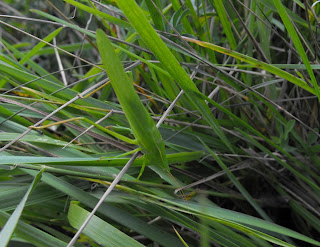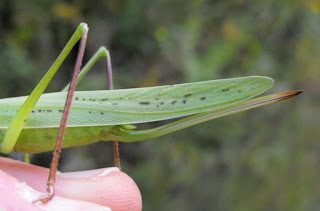Tuesday, July 23, 2013
It's Time for Coneheads!
It seems that overnight, the songs of Sword-bearing Coneheads have suddenly filled the meadows of NE Ohio! Walking in Lake and Cuyahoga Counties in the past few days, a conehead was singing every several feet. They are impressive insects, and whenever participants on my insect song hikes find a Sword-bearing Conehead, they are thrilled! Let’s listen and take a look at these enchanting, beautiful coneheaded katydids.
Yes, they obviously have coneheads. In fact, one can identify the species by the shape of the cone and the amount of black on its tip. However, that would imply that it’s easy to get a good look at these insects and their cones. You’re going to have to work harder at this than you might expect!
See the Sword-bearing Conehead? She’s right there in the grass. In fact, she looks just like a blade of grass when she dives head first into the vegetation. That is exactly the plan.
It is far easier to identify them by their songs. The species we encounter here in NE Ohio sound quite different from each other, so it’s not so difficult.
Here is a singing male Sword-bearing Conehead:
How well you hear this – and how loud it seems to you – will depend on your high-frequency hearing. Conehead songs are loud, but they are also higher than many mid-life adults can hear at a distance. The most prominent frequencies in this particular recording are between 10,000 and 12,000 Hz. Tree crickets generally sing only between 3000 and 4000 Hz, so they are much easier to hear and sound like they have more distinct pitches.
Sword-bearing Coneheads, like crickets and katydids in general, sing lower and slower at cooler temperatures. They don’t start singing until dusk, and how long they sing into the night is determined in part by how far– and how quickly– the temperature drops. Insects are cold-blooded, and they can’t move their wings as fast on a chilly evening. They keep trying, but eventually they just grind to a halt and give up for the night. This conehead is singing at 60 degrees, and you can hear that his song is much slower than the conehead the first recording.
This species gets its common name from the very long ovipositor of the female – it does indeed look rather like a sword!
If someone does not know that ovipositors are for depositing eggs might think that the ovipositor is actually a giant stinger of some sort. But there is nothing to fear from a conehead. These insects are shy and gentle, and their only defense is to fly or hide.
Coneheads are seed eaters, and they especially seem to love grass seeds. I am always pleased to watch the males singing, but recently I had the opportunity to watch one enthusiastically dining and Cleveland Metroparks’ North Chagrin Reservation near the Cuyahoga/Lake county border.
Sword-bearing Coneheads will be singing for quite a while, so you’ll have time to hear them. I hope you also get to see at least one!
Subscribe to:
Post Comments (Atom)









No comments:
Post a Comment